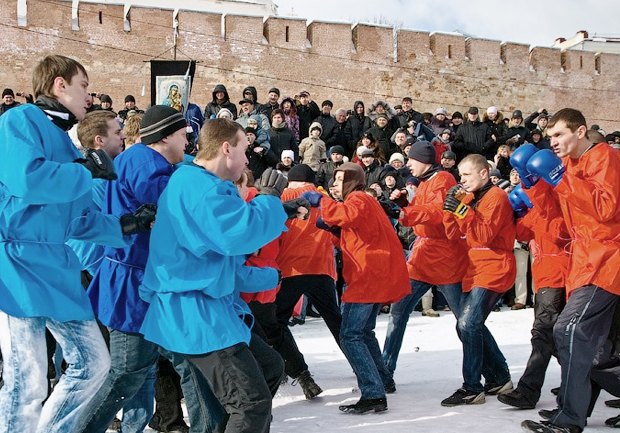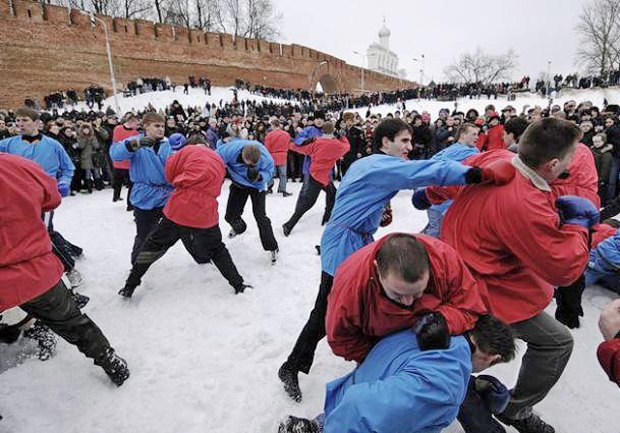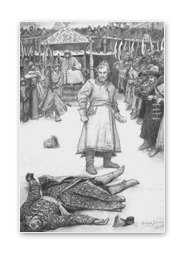Russian Futing Fights: Major Male Entertainment Maslenitsa
As you know, there is a passenger week, which implies a lot of different fun traditions. If most of them are understandable and accessible to even children, others over time went to the background. Today, at the request of Furfur, the author of the journal Interes Oleg Uppititsy recalls the main men's entertainment on Carnival - fist fights.
Traditional Russian fist fight
They fought, understandable, everything, always and everywhere. For one reason or another. Anyway. Eastern martial arts became part of the "path of self-improvement", the Indians of Central America arranged ritual fights, and the Greeks came up with the Olympic Games - dedicated to the gods, but served and excellent entertainment for many viewers who were collected every four years in Olympia town. Our ancestors from others have not lagged behind.
"Rules of Marquise Quinsberry", which appeared in 1865 and regulated the behavior of boxers, very similar to the rules of a fistful combat, formed by two and three centuries, organically respected in Russia.
In English, there was no wonder in Russia in Russia, the Russian Fist Fight is called Russian Fist - this is a really basic local "martial art." In terms of difficulty, the fisting battle is on one plank with other folk mordicular disciplines, not overloaded excessive fineness of the technician. Being somewhere in the middle between the French Savat and Irish boxing, he, however, is undeservedly located on the periphery of the attention of people interested in the techniques of combat and self-defense. It may be faithful to this - the rupture of the tradition, possibly - trends that have brought the first oriental disciplines to the fore, then Capoeur, and now - English boxing.
History of Russian fist fights
The first mention of Russian campaign can be found in the "Tale of Bygone Years". Nestor writes: "Sebo is not rigging whether we live ... Morals with all sorts of flattering, prevablami from God, pipes and scroorals, and guzzles, and Rusali; We see Bo playing clarified, and there are many people many people, Yako-to-knock out a friend's stomach tearly swelling of the blame of the case "- in general, criticizes.
Reading it, it should be understood that by leaving its roots to the pre-Christian cultural tradition, fist fights and could not be expected to have a different relationship from the Orthodox chronicler.
We do not know about the origin of a fist combat and its possible ritual meaning for ancient Slavs and cannot know for the same reasons. Nevertheless, about the development of a fist combat from the XI to the 20th century there is enough as historical and artistic testimony - poems and folk songs, decrees of banned battles, and police protocols, records of eyewitnesses and ethnographers, for which we can judge and about the rules of fights and about the procedure for fighting.
1.
Festival of Trinity near Tsareva Skrying, 1900. 2.
Mikhail Sands "Cutting Fight
with Ivan IV. " 3.
Fights "Wall on the wall". 4.
Modern fist fights.
So, for example, Nazimov in their memoirs says: "Local authorities seem to look at this ... Custom through your fingers, not having, probably, in view of the positive instructions of the authorities, and maybe the very worships themselves were the audience like the sternships, especially since many Significant in the city, people, champions of Starina, considered these fun very useful for the development and maintenance of the physical strength and the militant inclinations of the people. Yes, and wisely was the Arzamas city team, that is, he can cope with the help of 10-15 buddies and even a complete disabled team in 30-40 people with a collection of fighters, which, except for their numerous audience, stretched, according to eyewitnesses, up to 500 people " .
And Lebedev article for the magazine "Russian Starina" writes: "It was not at all a fight, a quarrel, a female or something like that, and something like playing. Meanwhile, the blows were convicted seriously, injured and even death. Fist fights exist in many countries, but everywhere they are character or competent - the sole, as, for example, boxing in England, or the fight, which was in our Dopurerovsky Rus; But in the way they have in Russia, - in the form of a contest of huge gatherings of the crowd, one with another, this is nowhere and never happened. Odom, an excess of forces asked outside and found an exit in such a kind of play.
|
About fist battles very little information, and in vain will look for them in history or benefits and monographs; News of them can be found only in the teachings of church and in memoirs. Meanwhile, there were many government orders about "fist battles", and had to even fight this kind of "sports". Usually, fist fights accounted for large holidays, in the summer were held on the streets or squares, and in the winter on the ice of frozen rivers and lakes - there was always enough space. Fist battles were not purely "regional" entertainment. In Moscow, the battles were held on the Moscow River at the Babigen Big Dam, Simonov and Novodevichy Monasteries and the Sparrow Mountains, in St. Petersburg - on the Ice of Neva and Fontanka. |
"Fist fight" V. Vasnetsov |
Fights were accompanied by festivities, spectators were gathered to the place of skirmishes, and with them and boxes with goods and bikers with hot honey and beer. Fights held with connivance or even in the presence of representatives of the nobility (for example, Count Orlov was a "big hunter to a fist combat"), they could be accompanied by Gypsy orchestras and even small fireworks.
Of course, spontaneous clashes regularly happened, when something could not share two streets or two banks of the river. Well, or long ago could not be divided, but only periodically remembered it.
|
The name "wall" occurs from the combat order adopted in such collisions - the parties arranged against each other in a dense line, consisting of several rows, and went to the wall of the enemy in order to break through it and turn her enemy.
Preparation for battle
The time and place of the battle were chosen in advance, the opposing parties, walls, prescribed leaders - the governor and stipulated specific rules. The leader of the wall in different places was called differently: Basholyk, head, older, combat elder, old cholovic.
On the eve of the battle, a leader, together with representatives of its wall, developed the plan of the upcoming battle: highlighting the strongest and more experienced fighters and distributed them to the places along the entire wall for the manual of individual groups that constitute the combat line of the wall. During the preparation, reserve fighters were prescribed for holding decisive attacks and special groups were distinguished in order to knock out any particular opponent from the battle. During the battle, the leaders of the parties did not only directly participate in it, but also encouraged their fighters and adjusted tactics on the go.

At P. P. Bazhov, in the "Broad Shoulder" taking place, the Bashma is instructed to their fighters: "Paid fighters, as it seemed better to him, and punishes, especially those who had previously walked in the root for the most reliable. "Look, without pampering with me. We are without a need, if you and a Mishka-Teddy's Gryshka on fun, you will become stronger to be measured. We need to have everyone at the same time, a wide shoulder. Act as mentioned ".
During the time remaining before the bout, the participants were preparing for her - ate more meat and bread, more often walked in the bath. "Magic" ways of training. So in one of the ancient hospitals is given a recommendation: "Kill the snake of a black saber or a knife, but to take a tongue from it, and invert in the taffeta green and in black, but put in your boot to the left, and douse in the same place. Walking away, back do not look back, and who will ask where you were, you don't tell with him. "
There were completely "magic" rites - for example, "breaking" (something like a ritual dance) before the fight, resembling the motion of the bear, whose cult existed in ancient Russia.
Before the fight, the fighters solemnly passed through the streets. Having come to the appointed place, lined up in the walls in three or four rows depending on the number of participants and began to lay out opponents with cries and gestures. At this time, the boys, representing the walls, converged between them in the "landfill". When all the participants were already enough razoreden, the leaders of the team shouted "give battle!" And the walls converged.
rules
There were restrictions that also spread on the battles "by himself":
- It was forbidden to beat the fallen, fastened (looked out of the surrendered) or the retreating enemy, as well as the enemy, who did not have the opportunity to independently stop the blood ("the smear does not beat") or a serious injury. The battle followed the face to face - to attack on the side or, even more so, from the back it is strictly forbidden ("from the wing, in the burden, in the rear not beat"). Also, it was not enough for clothes, the blows should be applied above the belt, any weapon was strictly prohibited. For a piece of lead, strained in a mitten, the culprit was awaited by a harsh punishment.
- The battle was conducted strictly fists, the sources talk about the use of blows of three types corresponding to the shock surfaces of the weapon:
- blowing knuckles, which was interpreted as an injection of a weapon;
- the base of the fist, which corresponded to a crushing or discarding;
- heads Folding Finger, like a scow.
The most common had shots in the head, in the solar plexus ("in the soul") and under the ribs ("under Mikitka"). Stone shoulder shoulders or two hands.
Mandatory outfit participants included thick caps and fur mittens, softening. Rovinsky in his book "Russian Folk Pictures", published in 1900 writes: "Before the fight was brought to the whole valves of the leather mittens; Litted parties factory with different factories, kovologists and butchers; Hunters happened from merchants, fur fur coats and even from the Lord. The whole of the oral was divided alveoyed and lined up in front of each other in two walls; The fight began, in small battles, - "crown" one one for one, then all the rest of the wall on the wall went; Spare fighters stood aside and took part in a fight only when their wall began to close the opposite wall. "
Stroke
The battle took place in three stages: first, adolescents were converging, representing the opposing parties, after them they joined the fighting young men, and adult men entered the latter. Sometimes these stages were divided among themselves - the boys were finished, the young men came together, and sometimes the battle was not interrupted, just participants entered the wall gradually.
Nazimov writes: "And so it began to shoot the boys, who, Galdi and teasing the opposite side, popped out with alone, put one different strikes, stuck off the legs and again ran" to their ". Separate clashes were rapidly, already groups, with Gick and Oran, attacked some others. The "walls" converged, and with a terrible hum, whistling, shouts, as the flow broken the dam, rapidly rushed "wall on the wall" - the real battle began. "
The fight was carried out on the opposition of the enemy with the "battlefield" or on the gap of its wall. Different tactics derived from military experience were used: the attack of the Wedge - "Pigs", replacing the fighters of the first and third rows and various maneuvers. Maxim Gorky in the novel "Life Matthew Kozhemyakina" describes a fistful fight: "Urban fights with tricks<…> The heels of good fighters are put forward from his "wall" against the chest, and when Slavezharan, bearing on them, unwittingly stretch to the wedge, the city will hit the city together with the sides, trying to smith the enemy. But Slobodsky got used to these drugs: vibrant retreating, they themselves cover the citizens with a semir ... "


An important category of fighters were hopes - powerful guys who ruptured the wall of the enemy. Often, the hope was let down, opening around the wall, and left alone with the masters of combat one on one that apparently was quite effective tactics.
Fist fights today
Despite the struggle of the authorities with fist battles, on the censure of their church and even legislative prohibitions, even the Soviet government could not finally crush this tradition. Thus, the newsreel of 1954 shows (with an indispensable disapproval) a fistful fight in the village of Purchae in the Ryazan region. The mention of these frames found B. V. Gorbunov, and A. S. Tedoradze was found to the newsreel and
I. A. Buchnev:
One of the last livelies of tradition was able to find the corner of the Tambov region at the end of the nineties of the last century in the late nineties of the last century in the village of Atamans. Looking at these strong old men, it's not so difficult to imagine what the walls of the time of their youth were.
The current country fighting clubs and near-footballs are also quite possible, albeit with the stretch, attributed to the continuation of this tradition. Therefore, we completed an article by another quote from Lebedev:
"Everything that can be said in conclusion is outlawed, it is to bring the words of the chronicler:" ... Our Land is great ... "and so on and add that fistful battles have experienced all laws and preserved, - for the intelligentsia they accepted the kind of athletic The struggle, on the scenes - as a paid sight, and in the very peoples continue the unavailable and considerably, not afteiting and the capitals, where they seem to be an anachronism; And it is practiced in the same species and scenes, as in a gray old antique, unless not so often and not in such ambitious sizes. "


